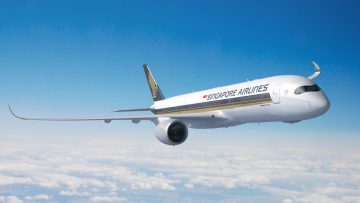
Qantas will begin operating three research flights later this year to test ways to improve the health and wellbeing of passengers and crew on ultra long-haul flights.
The flights form part of Qantas’ “Project Sunrise”, the airline’s goal to operate regular, non-stop commercial flights from Brisbane, Sydney and Melbourne to London and New York.
The research flights are scheduled to operate during October, November and December this year, using its new Boeing 787-9 aircraft scheduled for delivery during the same period. As a result, the planned delivery flights from Seattle to Australia will be re-routed, and the research flights will be operated with the new aircraft. Instead of flying empty from Seattle to Australia, the aircraft will simulate two Project Sunrise routes – London and New York to Sydney.
The two non-stop flights will take around 19 hours each, subject to wind and weather conditions. This will mark the world’s first non-stop flight between Sydney and New York operated by a commercial airline, and the second time a commercial airline has flown non-stop between Sydney and London. According to Qantas, it once flew non-stop from London to Sydney in 1989 to mark the entry into service of its Boeing 747-400 aircraft.
Each flight will carry a maximum of 40 people, including crew and cabin passengers who will mostly be Qantas employees. They will be provided with wearable technology devices and take part in specific experiences at varying stages of the circa-19 hour flights.
The on-board research will be conducted in partnership with Sydney University’s Charles Perkins Centre and Monash University in conjunction with the Cooperative Research Centre for Alertness, Safety and Productivity.
Scientists and medical experts from the Charles Perkins Centre will monitor sleep patterns, food and beverage consumption, lighting, physical movement and inflight entertainment to evaluate the impact on health, wellbeing and body clocks, while researchers from Monash University will work with pilots to record crew melatonin levels before, during and after the flights. Pilots will wear an EEG (electroencephalogram) device that tracks brain wave patterns and monitors alertness.
Alan Joyce, CEO of Qantas Group, said the flights will allow medical experts to conduct real-time research that will translate into health and wellbeing benefits.
He said: “For customers, the key will be minimising jet lag and creating an environment where they are looking forward to a restful, enjoyable flight. For crew, it’s about using scientific research to determine the best opportunities to promote alertness when they are on duty and maximise rest during their down time on these flights.
“Flying non-stop from the East Coast of Australia to London and New York is truly the final frontier in aviation, so we’re determined to do all the groundwork to get this right.”
He added that the airline is also looking at how it can use the data from the research flights to improve its existing long-haul flights.
Qantas has already gathered data on passenger sleep strategies on its direct Perth-London service, and some of these initial findings will be assessed further as part of these dedicated research flights. Customer feedback on food choices, separate stretching and wellbeing zones, as well as entertainment options, will also be tested.
According to the airline, Airbus and Boeing have pitched their A350 and Boeing 777X aircraft to Qantas for Project Sunrise flights. Qantas expects to give a final decision by the end of December this year, depending on aircraft economics, regulatory approvals and industrial agreements.
“There’s plenty of enthusiasm for Sunrise, but it’s not a foregone conclusion. This is ultimately a business decision and the economics have to stack up,” said Joyce.
Currently, the world’s longest commercial flight is Singapore Airlines’ daily Singapore-New York Newark service. Business Traveller reviewed this ultra long-range flight in May this year.
In late July, Qantas and American Airlines’ joint-venture partnership received government approval. This allows the Australian flag carrier to launch new non-stop service between Brisbane and the US cities of Chicago and San Francisco by the end of April next year, also using a Boeing 787-9 aircraft.












